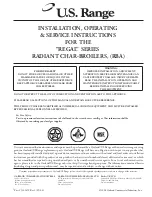
37
Making the safety connections
Safety equipment block installation instructions
1.
Install the safety lines.
Min. cross-sections:
Safety valve inlet connection
3 and 4 bar (0.3/0.4 MPa): Up to
160 kW
R 1
3 and 4 bar (0.3/0.4 MPa): From
200 kW
R 1
¼
6 bar (0.6 MPa)
R 1
Safety valve discharge pipe
3 and 4 bar (0.3/0.4 MPa): Up to
160 kW
R 1
¼
3 and 4 bar (0.3/0.4 MPa): From
200 kW
R 1
½
6 bar (0.6 MPa)
R 1
¼
!
Please note
Connections subject to mechanical load can
cause appliance damage.
Connect the pipework free of load and tor-
que stress.
2.
Check the connections on the heating water side
for leaks.
Permiss. operating pres-
sure
6 bar (0.6 MPa)
Min. operating pressure
0.5 bar (0.05 MPa)
Test pressure
7.8 bar (0.78 MPa)
Low water indicator (water level limiter)
Tests have verified that the requirements to EN 12828
are met. This makes an additional low water indicator
unnecessary.
Safety valve
Equip the boilers with a safety valve. Only use safety
valves that are type-tested to TRD 721 and are desig-
nated in accordance with the system version.
Flue gas connection
Do not carry out
commissioning
until the following
conditions are met:
■
Free passage through the flue gas pipes.
■
Flue system with positive pressure is gas-tight.
■
Inspection port covers checked for secure and tight
seating.
■
Apertures for ensuring sufficient combustion air sup-
ply are open and cannot be closed off.
■
Applicable regulations on installing and commission-
ing flue systems have been followed.
Danger
Leaking or blocked flue systems or an insuffi-
cient supply of combustion air cause life threat-
ening poisoning due to carbon monoxide in the
flue gas.
Ensure the flue system functions correctly. Aper-
tures for combustion air supply must not be able
to be closed off.
Prevent condensate drainage via a wind protec-
tor.
Connections on the flue gas side
Note
Ensure the flue gas connection is free of load and tor-
que stress.
Flue system installation instructions
Flue gas connection:
7
200 mm
!
Please note
Balanced or standard flues must not come
loose.
Use floor or wall mounted fixing clamps (bal-
anced flue system accessories) to secure the
pipes in place.
Connect the flue outlet to the flue with the shortest
possible run, maintaining a slight rise (min. 3°). Avoid
sharp kinks.
Connections on the heating water side
(cont.)
5814780








































